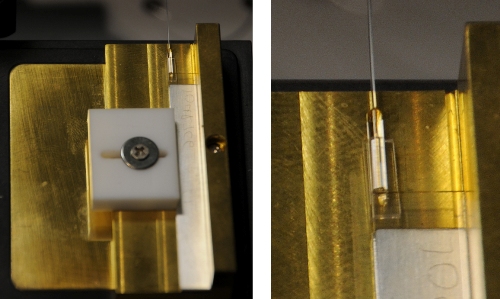The National Institute of Standards and Technology (NIST) has demonstrated that a new technique for splitting photon beams could tackle a basic physical barrier in electronic data transmission.
 Nearly transparent, this lithium niobate crystal (visible just above the white square section at bottom right of righthand photo) is capable of splitting a beam of photons into two beams of two different colors, an innovation that may help send quantum information through fiber optic cables, one of which is attached to the crystal at its top left corner and extends straight upward to the top of the photo frame. (credit: Talbott/NIST)
Nearly transparent, this lithium niobate crystal (visible just above the white square section at bottom right of righthand photo) is capable of splitting a beam of photons into two beams of two different colors, an innovation that may help send quantum information through fiber optic cables, one of which is attached to the crystal at its top left corner and extends straight upward to the top of the photo frame. (credit: Talbott/NIST)
This finding paves the way to develop commercial systems that is capable of protecting the transmission of sensitive data. The NIST study proves that a prototype device created with researchers at Stanford University is capable of doubling the amount of quantum data that can be readily transmitted through fiber-optic cables. In theory, even greater transmission rate is achievable.
Photons carry information by themselves, encoded in their quantum states. Thus, it is always possible to detect eavesdroppers because any attempt of data interception changes the quantum state. Although information scientists are able to encode photon quantum states, the wavelengths of the photons must be compatible with current optical-fiber networks and single-photon sensitive silicon detectors to realize practical systems. However, these wavelengths are not compatible.
One possible solution is to alter the wavelength of the photons from the infrared, which is advantageous for fiber networks, to the visible spectrum, and hence a silicon sensor can easily view them. It can be achieved by mixing the photons carrying the information with a second photon beam. By absorbing the additional energy of this second beam, the information-carrying photons move towards to the visible red light wavelength from the infrared region of the spectrum. Nevertheless, slow function of silicon single-photon detectors limits data rates and eventually their efficacy for quantum information transmission systems.
An innovative crystal designed and created by Jason Pelc from Stanford University is the key part of the newly developed device. The crystal can split the infrared, information-carrying photon beam into two slightly different-colored beams and direct the different-colored photons towards different outputs. Directing the flow towards either output enables two ‘slow’ detectors instead of one, which in turn increases the overall system speed to two folds.
NIST experiments demonstrated that this breakthrough device doubles the amount of data to be transmitted in a single beam. Paulina Kuo, one of the NIST researchers, stated that the photons can theoretically be split into more than two different beams, which means that even greater amount of information can be transmitted.